History of Casablanca
The history of the city of Casablanca in Morocco has been one of many political and cultural changes. At different times it has been governed by Berber, Roman, Arab, Portuguese, Spanish, French, British, and Moroccan regimes. It has had an important position in the region as a port city, making it valuable to a series of conquerors during its early history.
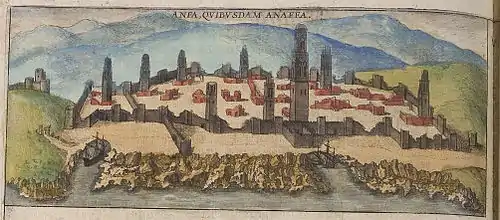
The original Berber name, Anfa (meaning: "hill" in English[1]), was used by the locals until the earthquake of 1755 destroyed the city. When Sultan Mohammed ben Abdallah rebuilt the city's medina, he gave it the name "ad-Dār al-Bayḍāʾ" (الدار البيضاء) a literal translation of Casablanca into Arabic.[2] French forces occupied the city in 1907 and adopted the Spanish name, Casablanca. The name Anfa now refers to an area within Casablanca, slightly West of the 18th century medina.
Roman Anfa
Anfa is a big city, built by the Romans on the ocean shore... —Leo Africanus
Leo Africanus defined Anfa as a city built by the Romans in his famous Descrittione dell’Africa (Description of Africa), written in the 16th century.
The area which is today Casablanca was founded and settled by the Berbers by about the 10th century BC.[3] It was used as a port by the Phoenicians and later by the Romans.[4]
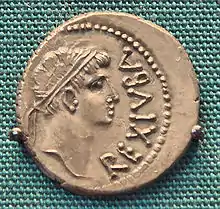
Romans occupied the area in 15 BC and created the important commercial port know later as Anfa,[5] directly connected to the Mogador island in the Iles Purpuraires of southern Mauritania. From there they obtained a special dye, that colored the purple stripe in Imperial Roman Senatorial togas. The expedition of Juba II to discover the Canary islands and Madeira probably departed from Anfa.
The Roman port, probably called initially Anfus in Latin language, was part of a Berber client state of Rome until Emperor Augustus. When Rome annexed Ptolemy of Mauretania's kingdom, Anfa was incorporated into the Roman Empire by Caligula. But this was done only nominally because the Roman limes was a few dozen kilometers north of the port (the Roman military fortifications of Mauretania Tingitana were just a few kilometers south of the Roman colonia named Sala Colonia). However, Roman Anfa—connected mainly by commerce and by socio-cultural ties to Volubilis ("autonomous" from Rome since 285 AD)—lasted until the 5th century, when Vandals conquered Roman northwestern Africa.
A Roman wreck of the 2nd century, from which were salvaged 169 silver coins, shows that the Romans appreciated this useful port for commerce. There is even evidence of oil commerce with Roman Volubilis and Tingis in the 3rd century. Probably there was a small community of Christians (linked to Roman merchants) in the port city until the fifth/sixth century.
Barghawata
A large Berber tribe, the Barghawata, settled in the area between the rivers Bou Regreg to the north and Oum er-Rbia to the south.[6] It established itself as an independent Berber kingdom in Tamasna around in 744 AD following the Berber Revolt against the Umayyad Caliph Hisham ibn Abd al-Malik. It remained until it was conquered by the Almoravids in 1068 AD.
Abou El Kassem El Ziani refers to ancient Casablanca as "Anfa" and stated that the Zenatiyins (Berber dynasty under Arab rule) were the first people that established Anfa in the period of their settlement in Tamassna.[7]
The Almohad Sultan Abd al-Mu'min drove the Barghawata out of Tamasna in 1149, and replaced them with Bedouin Arab tribes, notably Banu Hilal and Banu Sulaym.[8][9]
Early modern period
During the 14th century, under the Zenata Merinid Dynasty, the town rose in importance as a port and in the early 15th century, became independent once again. It emerged as a safe harbor for Barbary pirates. In 1468, the city was captured and destroyed by the Kingdom of Portugal and the Algarves under Rei Afonso V the African.[10] The Portuguese used the ruins to build a military fortress in 1515. The village that grew up around it was called "Casa Branca", meaning "White House" in Portuguese.
After the death of Rei Sebastian in the massive Portuguese defeat at the hands of the Moroccan Saadi Empire in the Battle of Alcácer Quibir and the ensuing crisis of succession, Casablanca came under Spanish occupation under the Iberian Union, from 1580 to 1640.[11]
They eventually abandoned the area completely in 1755 AD following an earthquake which destroyed it.

The town and the medina of Casablanca as it is today was founded in 1770 AD by Sultan Muhammad III ben Abdallah (1756–1790), the grandson of Moulay Ismail. Built with the aid of Spaniards, the town was called Casa Blanca (white house in Spanish) translated Dar el Beida in Arabic.
19th century
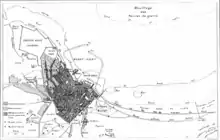
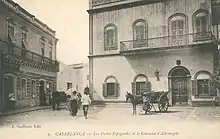
In the 19th century Casablanca became a major supplier of wool to the booming textile industry in Britain and shipping traffic increased (the British, in return, began importing Morocco's now famous national drink, gunpowder tea). By the 1860s, there were around 5,000 residents, and the population grew to around 10,000 by the late 1880s.[12] Casablanca grew due to the protégé system, through which Moroccans protected by European powers became independent of the Makhzen.[13] Casablanca was also one of the main Atlantic ports to receive Jewish migrants from the Moroccan hinterlands following the mission of Moses Montefiore to Morocco in 1864.[13]
Casablanca remained a modestly sized port, with a population reaching around 12,000 within a few years of the French conquest and arrival of French colonialists in the town, at first administrators within a sovereign sultanate, in 1906. By 1921, this was to rise to 110,000,[12] largely through the development of bidonvilles.
"Whereas Casablanca appears somewhat forbidding and hostile from the sea, it could not present a more welcoming picture to those traveling from inland. Its leafy gardens are topped by willowy palm trees, crenelated walls, flat roofs, and whitewashed minarets dazzling in the African sun; all this offers a striking backdrop against the deep blue of the natural haven that cradles svelte yachts and burly black and red steamboats."[13][14] - F. Weisgerber
French rule
French Invasion

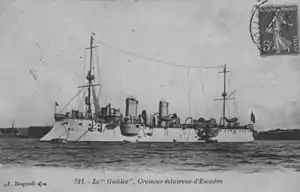
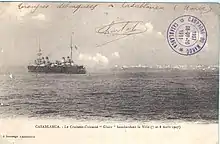
Following the Treaty of Algeciras in 1906, which granted the French holding company La Compagnie Marocaine rights to build modern ports in Casablanca and in Asfi, construction at the port of Casablanca began on May 2, 1907. A narrow gauge railway extending from the port to a quarry in Roches Noires for stones to build the breakwater, passed over the Sidi Belyout necropolis, an area held sacred by the Moroccans. In addition, the French had started to control the customs.[16]
On July 28, a delegation representing the tribes of the Chaouia, led by Hajj Hamou of the Ouled Hariz tribe, pressed Abu Bakr Bin Buzaid (بوبكر بن بوزيد السلاوي), qaid of Casablanca and representative of Sultan Abdelaziz and the Makhzen in the city, with 3 demands: the removal of the French officers from the customs house, an immediate halt on the construction of the port, and the destruction of the railroad.[2]
The pasha equivocated and postponed his decision to mid-day on July 30, by which time regional tribesmen had populated the city and started an insurrection. A group waited for the train to make its way out to Roches Noires to pick up rocks from the quarry, then piled rocks onto the tracks behind it to isolate it. When the train returned, it was ambushed and the French, Spanish, and Italian workers aboard were killed and the train destroyed.[17]
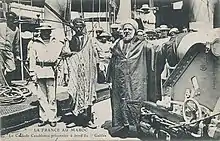
This was the justification the French had been waiting for. From August 5–7, a fleet of French armored cruisers bombarded Casablanca and French troops were landed, marking the beginning of the invasion of Morocco. The French then took control of Casablanca and the Chaouia. This effectively began the process of colonization, although French control of Casablanca was not formalized until the signature of the Treaty of Fez March 30, 1912.
Commercial explosion
The city overflowed outside of its walls; a West African quarter and a mass of sordid adobe constructions.[18] were built around Bab Marrakesh. The market gate was surrounded by warehouses and shops. inside the walls, was is the Moroccan city, semi-modern in places: winding streets, point or poorly paved, that the slightest rain changes in mud-holes, narrow squares, tightened between terraced houses, low and without architecture A apart from the mosques, a few residential doors and the German consulate, no monument attracts the gaze of the visitor "lieutenant segongs, 1910".
Colonial port
Hubert Lyautey was the first French military governor in Morocco, with the title résident général. In 1913, Lyautey invited Henri Prost to handle the urban planning of Moroccan cities, and his work in Casablanca was lauded for applying principles of urbanization.[19] The ville européenne or "European city" fanned out Eastward around Casablanca's medina, or—as the French called it—la ville indigène. The area just outside the eastern walls of the medina, which had previously been used as a market space, Assouq Elkbiir (السوق الكبير) the "big market", was transformed into Place de France, now known as United Nations Square. Dominated by the clock tower built in 1908, it demarked a contact point between the Moroccan medina and the European nouvelle ville.
In 1915, the French authorities held the Exposition Franco-Marocaine, a display of French soft power after the bombardment of the city in 1907 and during the ongoing pacification or wars of occupation—notably the Zaian War—and an opportunity to inventory Morocco's resources and crafts.[20][21]
In 1930, Casablanca hosted a round of the Formula One world championship. The race was held at the new Anfa Racecourse. In 1958, the race was held at Ain-Diab circuit - (see Moroccan Grand Prix). In 1983, Casablanca hosted the Mediterranean Games.
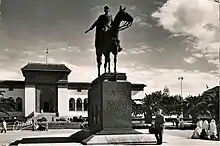
Under Lyautey's tenure, Casablanca transformed into Morocco's economic center and Africa's biggest port. Casablanca's street plan is based on that of a French architect named Henri Prost, who placed the center of the city where the main market of Anfa had been. From this point all main streets radiate to the east and to the south.
A 1937-1938 typhoid fever outbreak was exploited by colonial authorities to justify the appropriation of urban spaces in Casablanca.[23][24] Bidonvilles were cleated out of the center and their residents displaced.[23]
The famous 1942 film Casablanca underlined the city's colonial status at the time—depicting it as the scene of a power struggle between competing European powers, carried out without any reference to the local population, and with the film's vast cosmopolitan cast of characters (American, French, German, Czech and some other nationalities) including not a single Arab.
World War II
Casablanca was an important strategic port during World War II. In November 1942, the British and Americans organised a 3-pronged attack on North Africa (Operation Torch), of which the westernmost one was at Casablanca.
The Task Force landed before daybreak on 8 November 1942, at three points in Morocco: Asfi (Operation Blackstone), Fedala (Operation Brushwood, the largest landing with 19,000 men), and Mehdiya-Port Lyautey (Operation Goalpost). Because it was hoped that the French would not resist, there were no preliminary bombardments. This proved to be a costly error as French defenses took a toll of American landing forces.
On the night of 7 November, pro-Allied General Antoine Béthouart attempted a coup d'etat against the French command in Morocco, so that he could surrender to the Allies the next day. His forces surrounded the villa of General Charles Noguès, the Vichy-loyal high commissioner. However, Noguès telephoned loyal forces, who stopped the coup. In addition, the coup attempt alerted Noguès to the impending Allied invasion, and he immediately bolstered French coastal defenses.
- Front pages of Le Petit Marocain
 November 8, 1942: North Africa Attacked by Anglo-American Forces
November 8, 1942: North Africa Attacked by Anglo-American Forces November 11, 1942: Ceasefire Decided Tonight
November 11, 1942: Ceasefire Decided Tonight November 12, 1942: Hostilities Have Ceased Throughout North Africa
November 12, 1942: Hostilities Have Ceased Throughout North Africa
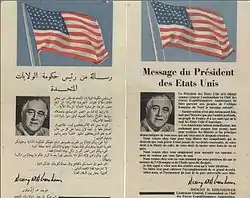
At Safi, the objective being capturing the port facilities to land the Western Task Force's medium tanks, the landings were mostly successful.[25] The landings were begun without covering fire, in the hope that the French would not resist at all. However, once French coastal batteries opened fire, Allied warships returned fire. By the time General Ernest Harmon's 2nd Armored Division arrived, French snipers had pinned the assault troops (most of whom were in combat for the first time) on Safi's beaches. Most of the landings occurred behind schedule. Carrier aircraft destroyed a French truck convoy bringing reinforcements to the beach defenses. Safi surrendered on the afternoon of 8 November. By 10 November, the remaining defenders were pinned down, and the bulk of Harmon's forces raced to join the siege of Casablanca.
At Port-Lyautey, the landing troops were uncertain of their position, and the second wave was delayed. This gave the French defenders time to organize resistance, and the remaining landings were conducted under artillery bombardment. With the assistance of air support from the carriers, the troops pushed ahead, and the objectives were captured.
At Fedala, weather disrupted the landings. The landing beaches again came under French fire after daybreak. Patton landed at 08:00, and the beachheads were secured later in the day. The Americans surrounded the port of Casablanca by 10 November, and the city surrendered an hour before the final assault was due to take place.
Casablanca hosted the Casablanca Conference -called even "Anfa Conference"- in 1943 (from January 14 to January 24), in which Churchill and Roosevelt discussed the progress of the war. Casablanca was the site of a large American air base, which was the staging area for all American aircraft for the European Theater of Operations during World War II.
Post-war period
In April 1953, film Salut Casa!—a "pseudo-documentary" propaganda piece intended for French audiences—played at the Cannes Film Festival. The film shows the colonial machine carrying out its mission civilizatrice at full steam.[26] The French government described Casablanca as a "laboratory of urbanism,"[26] and the French urbanist Michel Écochard—director of the Service de l’Urbanisme, Casablanca's urban planning office at the time—featured prominently in the film, discussing how challenges such as internal migration and rapid urbanization were being handled in Casablanca.[26]
In July of the same year, Morocco and its Groupe des Architectes Modernes Marocains (GAMMA) had its own section at the Congrès Internationaux d'Architecture Moderne or CIAM.[27] The architects from Morocco presented an intense study of daily life in Casablanca's bidonvilles.[28] To consider the ad-hoc huts built by penniless immigrants from rural parts of the country worthy of study—let alone to hold them as examples for modernist architects to learn from—was radical and revolutionary, and caused a schism among modernists.[29][28][30][31]
Young architects of the controversial Team X, such as Shadrach Woods, Alexis Josic, and Georges Candilis were active in Casablanca designing cités, modular public housing units, that took vernacular life into account.[32] Elie Azagury, the first Moroccan modernist architect, led GAMMA after independence in 1956.[33][29]
Toward Independence
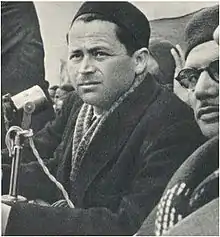
During the 1940s and 1950s, Casablanca was a major center of anti-colonial struggle.
In 1947, when the Sultan went to the Tangier International Zone to deliver a speech requesting independence from colonial powers, the first stage of the Revolution of the King and the People, French colonial forces instigated a conflict between Senegalese Tirailleurs serving the French colonial empire and Moroccan locals in a failed attempt to sabotage the Sultan's journey to Tangier. This massacre, remembered in Casablanca as Darbat Salighan (Moroccan Arabic: ضربة ساليغان), lasted for about 24 hours from April 7–8, 1947, as the tirailleurs fired randomly into residential buildings in working-class neighborhoods, killing between 180 and 1000 Moroccan civilians.[35] The Sultan returned to Casablanca to comfort the families of the victims, then proceeded to Tangier to deliver the historic speech.[36][37]
The assassination of the Tunisian labor unionist Farhat Hached by La Main Rouge—the clandestine militant wing of French intelligence—sparked protests in cities around the world and riots in Casablanca from December 7–8, 1952.[34] The Union Générale des Syndicats Confédérés du Maroc (UGSCM) and the Istiqlal Party organized a general strike in the Carrières Centrales in Hay Mohammadi on December 7.[38]
On December 24, 1953, in response to violence and abuses from French colonists culminating in the forced exile of Sultan Mohammed V on Eid al-Adha, Mohammed Zerktouni orchestrated the bombing of the Central Market, killing 16 people.[39][40]
Since independence
Morocco regained independence from France on 2 March 1956.
Casablanca Group
January 4–7, 1961, the city hosted an ensemble of progressive African leaders during the Casablanca Conference of 1961. King Muhammad V received attendance were Gamal Abd An-Nasser of the United Arab Republic, Kwame Nkrumah of Ghana, Modibo Keïta of Mali, and Ahmed Sékou Touré of Guinea, as well as Ferhat Abbas, president of the Provisional Government of the Algerian Republic.[41] Notably absent was Patrice Lumumba of the Republic of the Congo, who had been in prison since September 1960.[41] This conference gave birth to the pan-Africanist Casablanca Group or the "Casablanca Bloc" and ultimately to the African Union.[42][43][41]
Jewish emigration
Casablanca was a major departure point for Jews leaving Morocco through Operation Yachin, an operation conducted by Mossad to secretly migrate Moroccan Jews to Israel between November 1961 and spring 1964.[44]
1965 riots
The 1965 student protests, which spread to cities around the country and devolved into riots, started on March 22, 1965 in front of Lycée Mohammed V in Casablanca; there were almost 15,000 students there, according to a witness.[45][46][47] The protests started as a peaceful march to demand the right to public higher education for Morocco, but were violently dispersed. The following day, students returned to Lycée Mohammed V along with workers, the unemployed, and the poor, this time vandalizing stores, burning buses and cars, throwing stones, and chanting slogans against King Hassan II, who since assuming the throne in 1961, had consolidated political power within monarchy and gone to war with the newly independent, newly socialist Algeria.[48] The National Union of the Students of Morocco—a nationalist, anti-colonial student group affiliated with Mehdi Ben Barka's party, the National Union of Popular Forces—overtly opposed and criticized Hassan II.[49][50]
The riots were repressed with tanks deployed for two days, and General Mohamed Oufkir fired on the crowd from a helicopter.[51][52]
The king blamed the events on teachers and parents, and declared in a speech to the nation on March 30, 1965: "Allow me to tell you that there is no greater danger to the State than a so-called intellectual. It would have been better if you were all illiterate.”[53][54]
1965 Arab League Summit

A secret Arab League summit was held in Casablanca September 1965. Shlomo Gazit of Israeli intelligence said that Hassan II invited Mossad and Shin Bet agents to bug the Casablanca hotel where the conference would be held to record the conversations of the Arab leaders.[55] This information was instrumental in the heavy military defeats of Egypt, Jordan and Syria to the Israelis in the Six-Day War.[55] Prior to the war, King Hassan II had developed a reciprocal relationship with the Israeli intelligence, who had assisted him in carrying out an operation in France to abduct and 'disappear' Mehdi Ben Barka, a leftist Moroccan leader who had been based in Paris.[56]
Years of Lead
During the "Years of Lead," Derb Moulay Cherif Prison in Hay Muhammadi was used as a secret prison for the interrogation and torture of dissidents of Hassan II.[57] Among others, the Jewish Moroccan activist Abraham Serfaty of the radical Moroccan leftist group Ila al-Amam was tortured there.[57] The poet and activist Saida Menebhi died there on December 11, 1977 after a 34-day hunger strike.[58]
The music of Nass El Ghiwane represents some of the art that was created in opposition to the oppressive regime.[59]
1981 riots
On May 29, 1981, riots broke out in Casablanca.[60][61] At a time when Morocco was strained from six years in the Western Sahara War, a general strike was organized in response to increases in the cost of basic foods.[60] Thousands of young people from the bidonvilles surrounding Casablanca formed mobs and stoned symbols of wealth in the city, including buses, banks, pharmacies, grocery stores, and expensive cars.[60] Police and military units fired into the crowds.[60] The official death toll according to the government was 66, while the opposition reported it was 637, most of whom were youths from the slums shot to death.[60] This intifada was the first of two IMF riots in Morocco—dubbed the "Hunger Revolts" by the international press—the second of which took place in 1984 primarily in northern cities such as Nador, Husseima, Tetuan, and al-Qasr al-Kebir.[61][62]
Globalization and modernization
The first McDonald's franchise on the African continent and in the Arab world opened on Ain Diab in 1992.[63]
The city is now developing a tourism industry. Casablanca has become the economic and business capital of Morocco, while Rabat is the political capital.
In March 2000, women's groups organised demonstrations in Casablanca proposing reforms to the legal status of women in the country. 40,000 women attended, calling for a ban on polygamy and the introduction of divorce law (divorce being a purely religious procedure at that time). Although counter-demonstration attracted half a million participants, the movement for change started in 2000 was influential on King Mohammed VI, and he enacted a new Mudawana, or family law, in early 2004, meeting some of the demands of women's rights activists.
On May 16, 2003, 33 civilians were killed and more than 100 people were injured when Casablanca was hit by a multiple suicide bomb attack carried out by Moroccans and claimed by some to have been linked to al-Qaeda.
A string of suicide bombings struck the city in early 2007. A suspected militant blew himself up at a Casablanca internet cafe on March 11, 2007. On April 10, three suicide bombers blew themselves up during a police raid of their safe house.[64] Two days later, police set up barricades around the city and detained two more men who had escaped the raid.[65] On April 14, two brothers blew themselves up in downtown Casablanca, one near the American Consulate, and one a few blocks away near the American Language Center. Only one person was injured aside from the bombers, but the Consulate was closed for more than a month.[66]
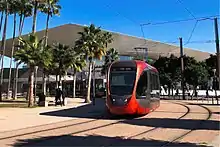
The first line of the Casablanca Tramway, which as of 2019 consists of two lines, was inaugurated December 2012.[67] Al-Boraq, a high speed rail service connecting Casablanca and Tangier and the high-speed rail service on the African continent, was inaugurated on November 15, 2018.[68]
See also
References
- Miller, Catherine (2007). Arabic in the City: Issues in Dialect Contact and Language Variation. Routledge. p. 100. ISBN 978-0-415-77311-9. Retrieved 22 April 2012.
- Adam, André (1963). Histoire de Casablanca: des origines à 1914. Aix En Provence: Annales de la Faculté des Lettres Aix En Provence, Editions Ophrys. p. 62.
- Casablanca - Jewish Virtual Library
- LexicOrient
- Roman Casablanca
- Roman Anfa
- Berber Casablanca Archived 2011-07-19 at the Wayback Machine
- S. Lévy, Pour une histoire linguistique du Maroc, dans Peuplement et arabisation au Maghreb occidental: dialectologie et histoire, 1998, pp.11-26 (ISBN 84-86839-85-8)
- cf. Marçais, Les Arabes en Berbérie, p. 523 sq. et 532 sq.
- Kohn, George Childs (2013-10-31). Dictionary of Wars. Routledge. ISBN 978-1-135-95494-9.
- Romanelli, Samuel Aaron; Stillman, Yedida Kalfon; Stillman, Norman A. (1989). Travail in an Arab land. University of Alabama Press. ISBN 978-0-8173-0409-6.
casablanca 1580 1640 Spain.
- Pennel, CR: Morocco from Empire to Independence, Oneworld, Oxford, 2003, p 121
- Cohen, Jean-Louis, author. (2002). Casablanca : colonial myths and architectural ventures. ISBN 1-58093-087-5. OCLC 49225856.CS1 maint: multiple names: authors list (link)
- Weisgerber, F. (1904). Trois mois de campagne au Maroc: étude géographique de la région parcourue (in French). Leroux.
- R., Pennell, C. (2000). Morocco since 1830 : a history. London: Hurst & Co. p. 135. ISBN 1850654263. OCLC 42954024.
- Adam, André (1963). Histoire de Casablanca: des origines à 1914. Aix En Provence: Annales de la Faculté des Lettres Aix En Provence, Editions Ophrys. pp. 103–135.
- Adam, André (1963). Histoire de Casablanca: des origines à 1914. Aix En Provence: Annales de la Faculté des Lettres Aix En Provence, Editions Ophrys. pp. 103–135.
- Cohen, Jean-Louis (1998). Casablanca: mythes et figures d'une aventure urbaine. ISBN 2850256242.
- Cohen, Jean-Louis. Henri Prost and Casablanca: the art of making successful cities (1912-1940). The New City, (fall 1996), № 3, p. 106-121.
- Gambini, J. B. Photographe (1915). "Exposition Franco-Marocaine. Casablanca, 1915 / J. B. Gambini". Gallica. Retrieved 2019-03-20.
- Irbouh, Hamid (2005). Art in the Service of Colonialism: French Art Education in Morocco, 1912-1956. New York: I.B. Tauris & Co. p. 59. ISBN 1-85043-851-X.
- "Histoire du Consulat". Les Consulats Généraux de France au Maroc (in French). Retrieved 2020-03-19.
- House, Jim (2012). "L'impossible contrôle d'une ville coloniale ?". Genèses. 86 (1): 78. doi:10.3917/gen.086.0078. ISSN 1155-3219.
- "Casablanca 1952: Architecture For the Anti-Colonial Struggle or the Counter-Revolution". THE FUNAMBULIST MAGAZINE. 2018-08-09. Retrieved 2019-10-18.
- Howe 1993, pp. 97, 102.
- Von Osten, Marion. Müller, Andreas. "Contact Zones". Pages Magazine. Archived from the original on 2019-10-18. Retrieved 2019-10-18.CS1 maint: uses authors parameter (link)
- Dahmani, Iman; El moumni, Lahbib; Meslil, El mahdi (2019). Modern Casablanca Map. Translated by Borim, Ian. Casablanca: MAMMA Group. ISBN 978-9920-9339-0-2.
- "The Gamma Grid | Model House". transculturalmodernism.org. Retrieved 2019-10-18.
- Dahmani, Iman; El moumni, Lahbib; Meslil, El mahdi (2019). Modern Casablanca Map. Translated by Borim, Ian. Casablanca: MAMMA Group. ISBN 978-9920-9339-0-2.
- Chnaoui, Aziza (2010-11-02). "Depoliticizing Group GAMMA: contesting modernism in Morocco". In Lu, Duanfang (ed.). Third World Modernism: Architecture, Development and Identity. Routledge. ISBN 9781136895487.
- Pedret, Annie. "TEAM 10 Introduction". www.team10online.org. Retrieved 2019-10-18.
- "Adaptations of Vernacular Modernism in Casablanca". Retrieved 2019-10-18.
- Chaouni, Aziza (2014-07-03). "Interview with Elie Azagury". Journal of Architectural Education. 68 (2): 210–216. doi:10.1080/10464883.2014.943632. ISSN 1046-4883.
- Yabiladi.com. "7-8 décembre 1952 : Quand les Casablancais se sont soulevés contre l'assassinat de Ferhat Hached". www.yabiladi.com (in French). Retrieved 2019-03-16.
- "في مثل هذا اليوم قبل 69 سنة سقط ألف من المغاربة بدرب الكبير في "ضربة ساليغان"". فبراير.كوم | موقع مغربي إخباري شامل يتجدد على مدار الساعة (in French). 2016-04-07. Retrieved 2020-04-08.
- Atlasinfo. "Evènements du 7 avril 1947 à Casablanca, un tournant décisif dans la lutte pour la liberté et l'indépendance". Atlasinfo.fr: l'essentiel de l'actualité de la France et du Maghreb (in French). Retrieved 2019-03-16.
- Revisiting the colonial past in Morocco. Maghraoui, Driss. London: Routledge. 2013. p. 151. ISBN 9780415638470. OCLC 793224528.CS1 maint: others (link)
- "Casablanca 1952: Architecture For the Anti-Colonial Struggle or the Counter-Revolution". THE FUNAMBULIST MAGAZINE. 2018-08-09. Retrieved 2019-10-18.
- Yabiladi.com. "Histoire : Le Noël sanglant du marché central de Casablanca". www.yabiladi.com (in French). Retrieved 2019-03-16.
- "16 Dead in Casablanca Blast". New York Times. 25 December 1953. Retrieved 4 October 2010.
- "La Conférence de Casablanca". Zamane (in French). 2012-11-30. Retrieved 2019-06-01.
- Yabiladi.com. "4 au 7 janvier 1961 : La Conférence de Casablanca, prélude à la création de l'OUA". www.yabiladi.com (in French). Retrieved 2019-05-28.
- "African States of the Casablanca Charter | UIA Yearbook Profile | Union of International Associations". uia.org. Retrieved 2019-05-28.
- Frédéric Abécassis. Questions about jewish migrations from Morocco: ”Operation mural” (summer 1961) : return from diaspora or formation of a new diaspora ?. Questions about jewish migrations from Morocco, Jun 2012, Jérusalem, Israel. pp.73-82. ffhalshs-00778664f https://halshs.archives-ouvertes.fr/file/index/docid/778664/filename/NEW_DIASPORAS._THE_JERUSALEM_WORKSHOP._JUNE_2012.pdf
- Par Omar Brouksy, "Que s'est-il vraiment passé le 23 mars 1965?", Jeune Afrique, 21 March 2005. Archived.
- "Il y avait au moins quinze mille lycéens. Je n'avais jamais vu un rassemblement d'adolescents aussi impressionnant" as quoted in Brousky, 2005.
- Parker & Boum, Historical Dictionary of Morocco (2006), p. 213.
- Miller, A History of Modern Morocco (2013), pp. 162–166.
- Miller, A History of Modern Morocco (2013), pp. 162–168–169.
- Parker & Boum, Historical Dictionary of Morocco (2006), p. 344.
- Rollinde, Le Mouvement marocain des droits de l'Homme (2003), p. 123. “La répression est instantanée, l'armée apporte son renfort à la police et le général Oukfir n'hésite pas a mitrailler la foule depuis un hélicoptre. Les chars d'assaut mettront deux jours à venir à bout des derniers manifestants. Les victimes seront tres nombreuses, deux mille personnes passent devant les tribunaux.”
- Bruce Maddy-Weitzman, The Berber Identity Movement and the Challenge to North African States; University of Texas, 2011; p. 93.
- ”Permettez-moi de vous dire qu'il n'y a pas de danger aussi grave pour l'Etat que celui d'un prétendu intellectuel. Il aurait mieux valu que vous soyez tous illettrés.” Quoted in Rollinde, Le Mouvement marocain des droits de l'Homme (2003), p. 123.
- Susan Ossman, Picturing Casablanca: Portraits of Power in a Modern City; University of California Press, 1994; p. 37.
- Surkes, Sue. "Morocco tipped off Israeli intelligence, 'helped Israel win Six Day War'". www.timesofisrael.com. Retrieved 2019-07-07.
- Yabiladi.com. "History : 1965, when the Mossad helped Morocco murder Ben Barka". en.yabiladi.com. Retrieved 2019-07-07.
- Miller, Susan Gilson. (2013). A history of modern Morocco. New York: Cambridge University Press. p. 170. ISBN 9781139624695. OCLC 855022840.
- "11 décembre 1977: Saïda Menebhi décède en martyre marocaine" (in French). Retrieved 2019-06-01.
- "الأغنية الاحتجاجية بالمغرب .. فرقة "الغيوان" تندد بالقهر السياسي". Hespress (in Arabic). Retrieved 2019-12-21.
- "AS MOROCCO STARTS TO GAIN IN WAR, NATION ERUPTS". timesmachine.nytimes.com. Retrieved 2020-06-01.
- Clément, Jean-François (2013-09-18), Santucci, Jean-Claude (ed.), "Les révoltes urbaines", Le Maroc actuel : Une modernisation au miroir de la tradition ?, Connaissance du monde arabe, Institut de recherches et d’études sur les mondes arabes et musulmans, pp. 393–406, ISBN 978-2-271-08130-8, retrieved 2020-06-01
- Yabiladi.com. "Maroc : Les émeutes de 1984, quand Hassan II qualifait les manifestants de "Awbach"". www.yabiladi.com (in French). Retrieved 2020-06-01.
- "La saga McDonald's: 20 ans de présence au Maroc". L'Economiste (in French). 2012-05-11. Retrieved 2019-06-01.
- Terror Cell: 'Police Hold Fifth Man' Archived 2007-10-13 at the Wayback Machine April 12, 2007
- Casablanca on alert after suicide bombings April 12, 2007
- U.S. Shuts Morocco Consulate After Bomb April 15, 2007
- "Transport. Un tramway nommé plaisir". Telquel.ma (in French). Retrieved 2019-06-01.
- Ltd, DVV Media International. "Africa's first high speed line inaugurated". Railway Gazette. Retrieved 2019-06-23.
Further reading
External links
Maghreb Arabe Presse: 500k-year human fossil remains found in Casablanca (05/26/2006)
%252C_Algeria_04966r.jpg.webp)